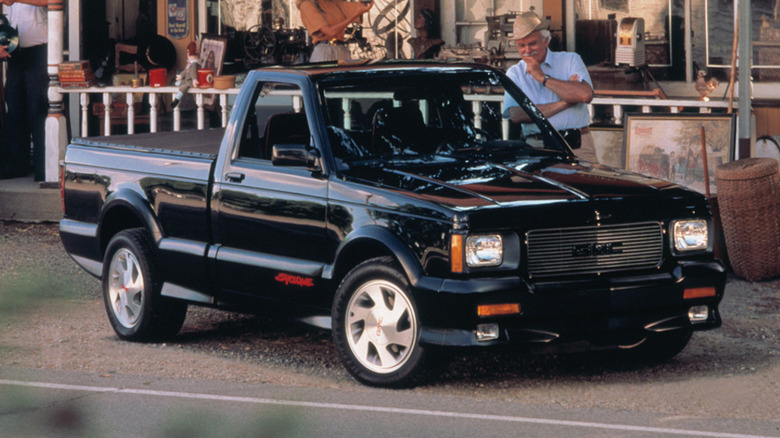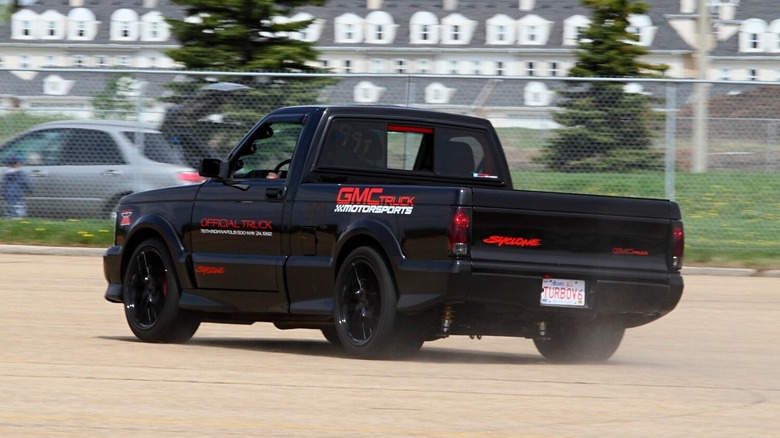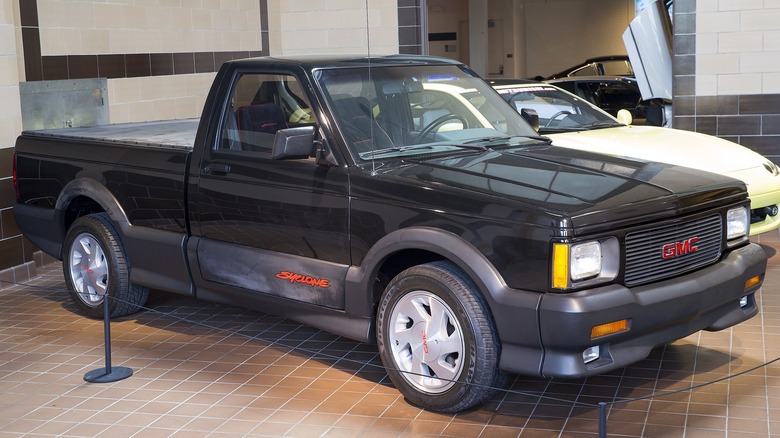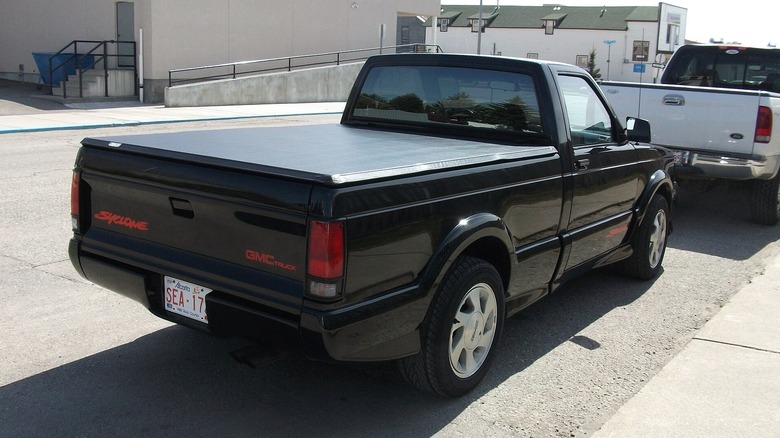GMC's Rocket Pick-Up: The History Behind The Lighting Fast Syclone
Nowadays, it's easy to take performance trucks for granted with mega-horsepower brutes like the Ram TRX and Ford Raptor available to anybody with a thick enough wallet, but thirty years ago, the idea was a fresh concept. Sure, some muscle trucks existed — particularly from Dodge in the late 1970s — but power was still limited by antiquated smog-era V8 engines and they didn't have the cornering ability to back up their straight-line gusto, such as it was. The groundbreaking GMC Syclone would change the public's perception of the humble pickup truck, but how did it all begin?
In recent years, GMC has cultivated an image of producing trucks and SUVs that are more upscale than its corporate cousin, Chevrolet. But back in the late 1980s, the brand flirted with an alternate approach of being the sporty counterpart to Chevy's trucks. The blank canvas it chose for the experiment was the S-15 compact pickup truck, a nearly identical sibling to Chevrolet's S-10 truck. To lessen confusion over the similar monickers, the S-15 was later renamed Sonoma.
In the late-1980s, a GMC designer named William Davis penned a lowrider S-15 show truck that surely had to represent the pinnacle of mini-trucks from that decade. It was all-white with white mesh wheels, the ubiquitous pink "pulse" graphic running down the side, and a Trans-Am style wing affixed to a fiberglass tonneau covering the cargo bed. If you could get over the now-dated looks, the prototype Syclone's most important feature resided under the hood: a 3.8 liter turbocharged V6 lifted directly from Buick's famed Grand National muscle car.
It had more horsepower than the turbo Buick that inspired it
After displaying the Syclone concept truck at several auto shows over the course of 1989 and receiving an overwhelmingly positive response, GMC decided to pull the trigger and produce a limited number of Syclones for public consumption. If you're wondering what's up with the creative spelling "Syclone," there's a theory that the name is a play on the S-series truck (S-10, S-15) or alternatively, Cyclone was already taken by a Ford/Mercury vehicle.
For reasons that aren't entirely clear, the Grand National's 3.8-liter engine required pricey modifications to work in the pickup truck environment at a production level. As an alternative, a 4.3 liter V6 which was already available in the S-15 truck was given the turbo treatment. Besides the turbocharger itself, the engine's internals were beefed up to handle the extra horsepower and it got a larger throttle body from the Corvette parts bin.
In the end, the larger displacement turbo V6 cranked out 280 horsepower and 350 pound-feet of torque, exceeding the output of the Grand National itself by approximately 40 horsepower. The only available transmission was a four-speed automatic which transferred the power to all four wheels via a BorgWarner transfer case from a GMC Safari van, of all sources, with a 65% bias to the rear wheels.
[Featured image by Grant.C via Wikimedia Commons | Cropped and scaled | CC BY 2.0]
Faster than a V8 Ferrari
The all-wheel-drive system was designed to improve traction and corner-hugging ability since pickup trucks notoriously lack traction at the rear axle when the cargo bed is empty, as it's apt to be on a Syclone. GMC did not want Syclone buyers to have the impression that the truck was off-road capable and went so far as to mount a warning label to the sun visor cautioning against off-road use. Besides not being able to venture off the pavement, the Syclone also had a comically low payload capacity of just 500 pounds and could only tow a 2,000-pound trailer, so it was a miserable failure as a traditional pickup truck. But how many traditional pickup trucks could out-accelerate a Corvette or Ferrari? The Syclone could.
In 1991, Car and Driver famously pitted the Syclone against a red Ferrari 348ts. In a zero to 60 MPH acceleration run, the GMC took a mere 5.3 seconds, compared to the Ferrari's 6.0 seconds. A classic quarter-mile drag race yielded similar results: 14.1 seconds for the Syclone versus 14.5 seconds for the 348ts.
[Featured image by Mr.choppers via Wikimedia Commons | Cropped and scaled | CC BY-SA 3.0]
The Syclone was replaced by the Typhoon SUV
Thankfully, the styling of the production model Syclone deviated considerably from the concept car. It had a more angular, less rounded ground effects package, bespoke aluminum alloy wheels with low-profile tires, and subtle red badging. Like the Buick Grand National that inspired it, buyers could have any color as long as it was black. With a base price of approximately $26,000 when new (equivalent to about $59,000 today), the Syclone wasn't exactly cheap, but it was still less pricey than a new Corvette and a relative bargain for the amount of performance it delivered.
In total, just less than 3,000 units were produced for the 1991 model year. For 1992, GMC intended to offer the sporty pickup truck in a wider variety of colors but it was killed off after just three 1992 models rolled off the assembly line. In its place was the Typhoon, a mechanically similar vehicle that was based on GMC's S-15 Jimmy, a two-door SUV. The Typhoon's SUV format was arguably a more appropriate platform for the turbocharged V6, with a rear seat for additional passengers and secure storage, but that practicality came at the expense of increased weight, and therefore decreased speed. The Syclone was still the king of speed in the early 1990s.
[Featured image by dave_7 via Wikimedia Commons | Cropped and scaled | CC BY 2.0]



